Organization Behavior: Personality Tests and Critical Evaluation
VerifiedAdded on 2023/06/04
|11
|2369
|329
AI Summary
This report provides a critical evaluation of personality tests such as Myers Briggs, McCrae’s Big 5 Personality Traits, Thomas-Kilmann Conflict Mode Instrument and McClelland Needs Analysis. The report highlights strengths and weaknesses and provides an action plan for improvement.
Contribute Materials
Your contribution can guide someone’s learning journey. Share your
documents today.
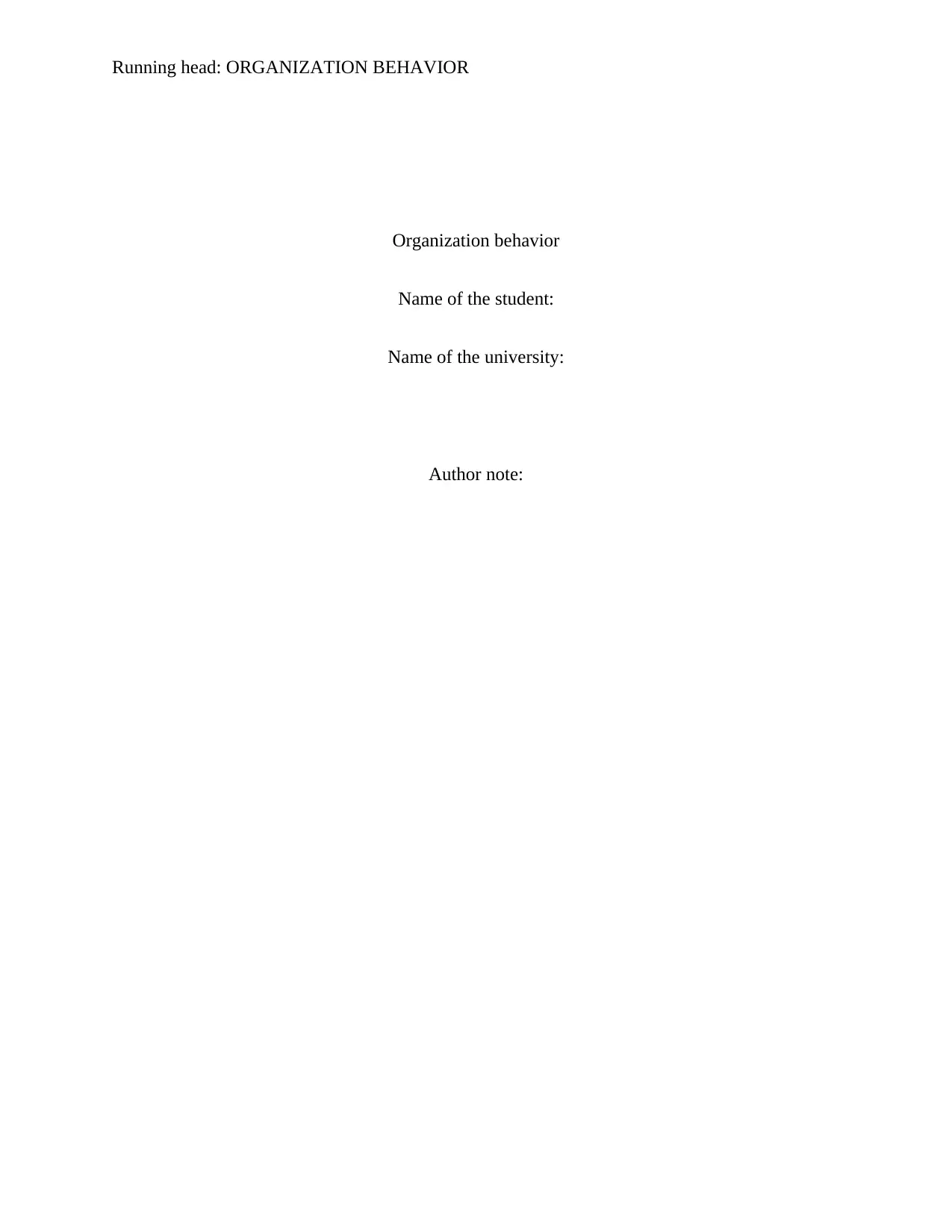
Running head: ORGANIZATION BEHAVIOR
Organization behavior
Name of the student:
Name of the university:
Author note:
Organization behavior
Name of the student:
Name of the university:
Author note:
Secure Best Marks with AI Grader
Need help grading? Try our AI Grader for instant feedback on your assignments.
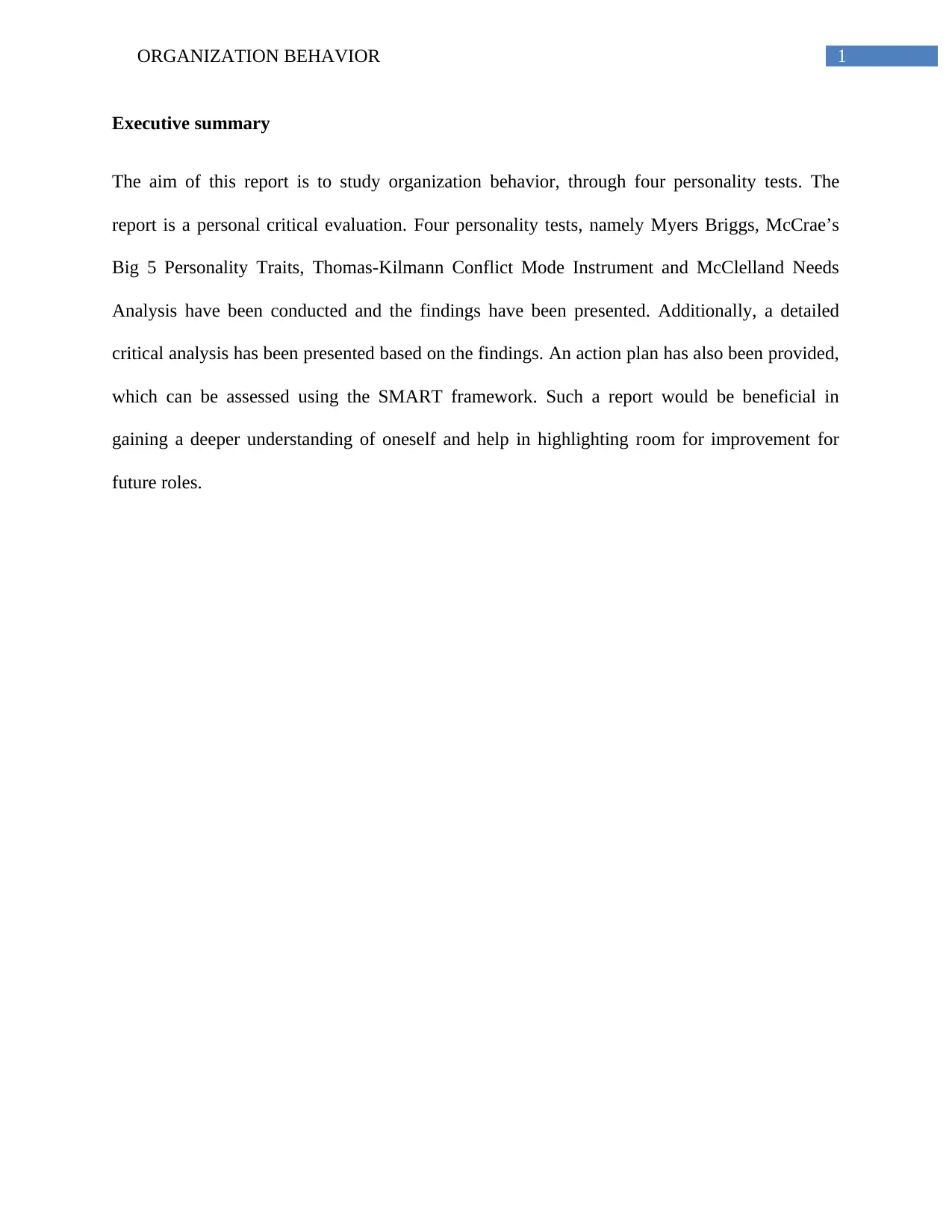
1ORGANIZATION BEHAVIOR
Executive summary
The aim of this report is to study organization behavior, through four personality tests. The
report is a personal critical evaluation. Four personality tests, namely Myers Briggs, McCrae’s
Big 5 Personality Traits, Thomas-Kilmann Conflict Mode Instrument and McClelland Needs
Analysis have been conducted and the findings have been presented. Additionally, a detailed
critical analysis has been presented based on the findings. An action plan has also been provided,
which can be assessed using the SMART framework. Such a report would be beneficial in
gaining a deeper understanding of oneself and help in highlighting room for improvement for
future roles.
Executive summary
The aim of this report is to study organization behavior, through four personality tests. The
report is a personal critical evaluation. Four personality tests, namely Myers Briggs, McCrae’s
Big 5 Personality Traits, Thomas-Kilmann Conflict Mode Instrument and McClelland Needs
Analysis have been conducted and the findings have been presented. Additionally, a detailed
critical analysis has been presented based on the findings. An action plan has also been provided,
which can be assessed using the SMART framework. Such a report would be beneficial in
gaining a deeper understanding of oneself and help in highlighting room for improvement for
future roles.
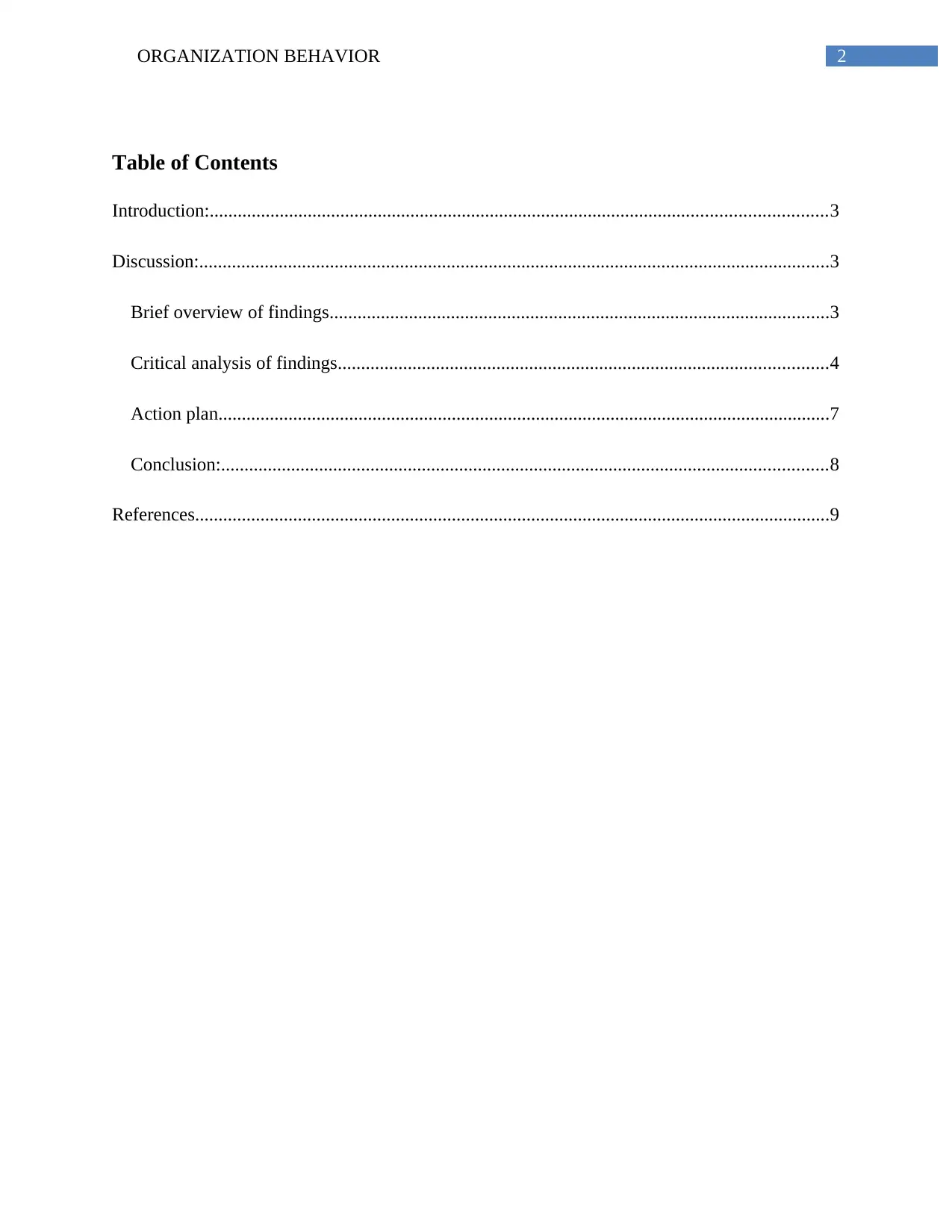
2ORGANIZATION BEHAVIOR
Table of Contents
Introduction:....................................................................................................................................3
Discussion:.......................................................................................................................................3
Brief overview of findings...........................................................................................................3
Critical analysis of findings.........................................................................................................4
Action plan...................................................................................................................................7
Conclusion:..................................................................................................................................8
References........................................................................................................................................9
Table of Contents
Introduction:....................................................................................................................................3
Discussion:.......................................................................................................................................3
Brief overview of findings...........................................................................................................3
Critical analysis of findings.........................................................................................................4
Action plan...................................................................................................................................7
Conclusion:..................................................................................................................................8
References........................................................................................................................................9

3ORGANIZATION BEHAVIOR
Introduction:
The main purpose of a personality test is to assess individual human constructs. Most of
the commonly used personality traits are usually introspective in nature and cause one to delve
deep into their individual selves (Kline 2015). Personality tests like Myers Briggs or McCrae’s
Big 5 Personality Traits test would one gain insight into the main component’s of one personality
and the very essence of their being. On a personal note, if I had to take up a leadership role or a
managerial role in the future, I would need to find a career that suits my personality. I took four
tests, namely Myers Briggs, McCrae’s Big 5 Personality Traits, Thomas-Kilmann Conflict Mode
Instrument and McClelland Needs Analysis. This report will discuss the results of these
personality traits.
Discussion:
Brief overview of findings
The Myers Briggs personality test had the following results: Extrovert (12 %), Thinking
(1%), Judging (28%) and Intuitive (12%). The result showed that I was more inclined towards
extroversion than introversion, intuition than sensing, almost no inclination towards thinking and
judging than perceiving. The McCrae’s Big 5 Personality Traits test had the following results –
Extroversion (11), agreeableness (12), conscientiousness (12), emotional stability (7.5) and
openness to new experience (9). The Thomas Kilmann Conflict Mode instrument showed that
my dominant style is accommodating teddy bear and my back up style is collaborating owl. The
McClelland Needs analysis showed that my achievement score is 24, my affiliation score is 19,
Introduction:
The main purpose of a personality test is to assess individual human constructs. Most of
the commonly used personality traits are usually introspective in nature and cause one to delve
deep into their individual selves (Kline 2015). Personality tests like Myers Briggs or McCrae’s
Big 5 Personality Traits test would one gain insight into the main component’s of one personality
and the very essence of their being. On a personal note, if I had to take up a leadership role or a
managerial role in the future, I would need to find a career that suits my personality. I took four
tests, namely Myers Briggs, McCrae’s Big 5 Personality Traits, Thomas-Kilmann Conflict Mode
Instrument and McClelland Needs Analysis. This report will discuss the results of these
personality traits.
Discussion:
Brief overview of findings
The Myers Briggs personality test had the following results: Extrovert (12 %), Thinking
(1%), Judging (28%) and Intuitive (12%). The result showed that I was more inclined towards
extroversion than introversion, intuition than sensing, almost no inclination towards thinking and
judging than perceiving. The McCrae’s Big 5 Personality Traits test had the following results –
Extroversion (11), agreeableness (12), conscientiousness (12), emotional stability (7.5) and
openness to new experience (9). The Thomas Kilmann Conflict Mode instrument showed that
my dominant style is accommodating teddy bear and my back up style is collaborating owl. The
McClelland Needs analysis showed that my achievement score is 24, my affiliation score is 19,
Secure Best Marks with AI Grader
Need help grading? Try our AI Grader for instant feedback on your assignments.
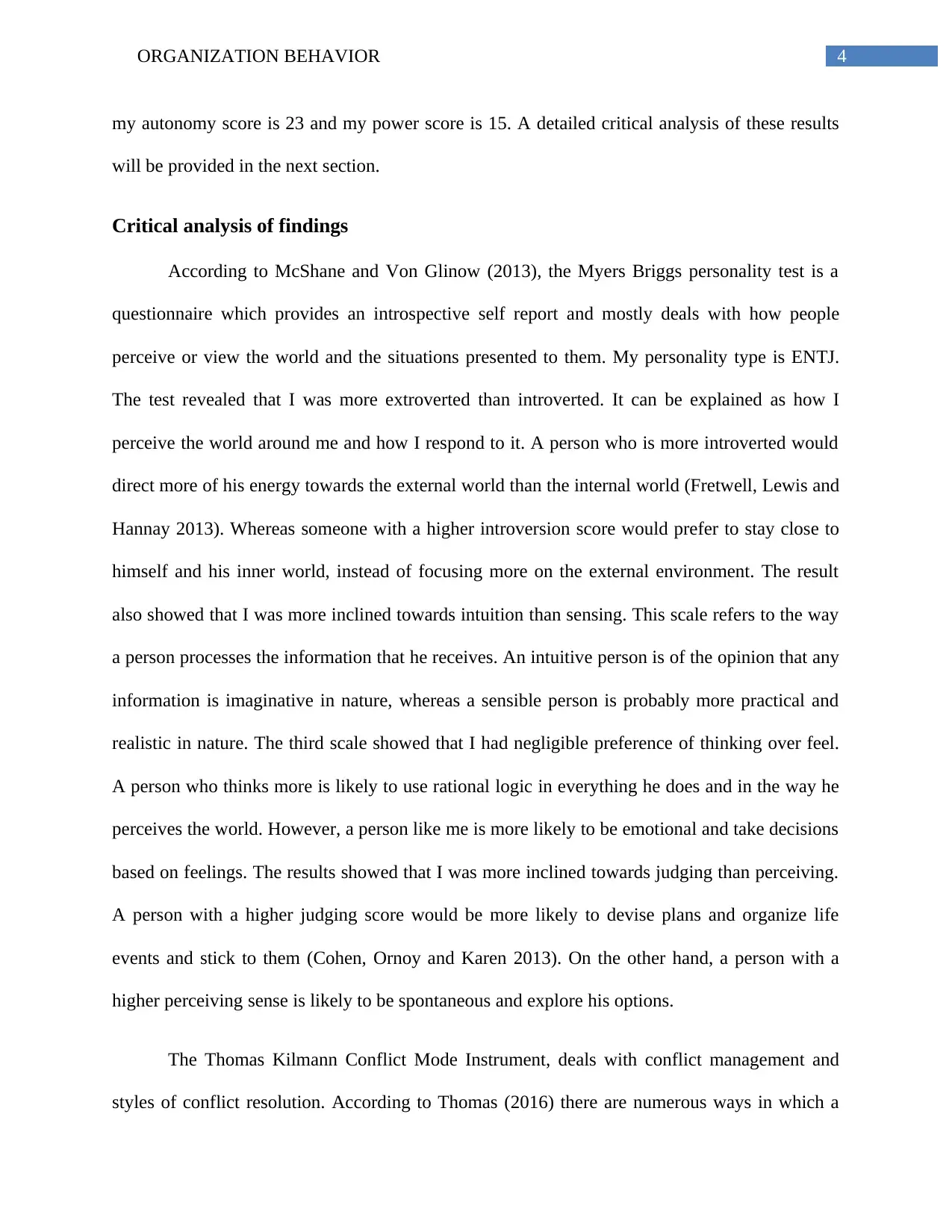
4ORGANIZATION BEHAVIOR
my autonomy score is 23 and my power score is 15. A detailed critical analysis of these results
will be provided in the next section.
Critical analysis of findings
According to McShane and Von Glinow (2013), the Myers Briggs personality test is a
questionnaire which provides an introspective self report and mostly deals with how people
perceive or view the world and the situations presented to them. My personality type is ENTJ.
The test revealed that I was more extroverted than introverted. It can be explained as how I
perceive the world around me and how I respond to it. A person who is more introverted would
direct more of his energy towards the external world than the internal world (Fretwell, Lewis and
Hannay 2013). Whereas someone with a higher introversion score would prefer to stay close to
himself and his inner world, instead of focusing more on the external environment. The result
also showed that I was more inclined towards intuition than sensing. This scale refers to the way
a person processes the information that he receives. An intuitive person is of the opinion that any
information is imaginative in nature, whereas a sensible person is probably more practical and
realistic in nature. The third scale showed that I had negligible preference of thinking over feel.
A person who thinks more is likely to use rational logic in everything he does and in the way he
perceives the world. However, a person like me is more likely to be emotional and take decisions
based on feelings. The results showed that I was more inclined towards judging than perceiving.
A person with a higher judging score would be more likely to devise plans and organize life
events and stick to them (Cohen, Ornoy and Karen 2013). On the other hand, a person with a
higher perceiving sense is likely to be spontaneous and explore his options.
The Thomas Kilmann Conflict Mode Instrument, deals with conflict management and
styles of conflict resolution. According to Thomas (2016) there are numerous ways in which a
my autonomy score is 23 and my power score is 15. A detailed critical analysis of these results
will be provided in the next section.
Critical analysis of findings
According to McShane and Von Glinow (2013), the Myers Briggs personality test is a
questionnaire which provides an introspective self report and mostly deals with how people
perceive or view the world and the situations presented to them. My personality type is ENTJ.
The test revealed that I was more extroverted than introverted. It can be explained as how I
perceive the world around me and how I respond to it. A person who is more introverted would
direct more of his energy towards the external world than the internal world (Fretwell, Lewis and
Hannay 2013). Whereas someone with a higher introversion score would prefer to stay close to
himself and his inner world, instead of focusing more on the external environment. The result
also showed that I was more inclined towards intuition than sensing. This scale refers to the way
a person processes the information that he receives. An intuitive person is of the opinion that any
information is imaginative in nature, whereas a sensible person is probably more practical and
realistic in nature. The third scale showed that I had negligible preference of thinking over feel.
A person who thinks more is likely to use rational logic in everything he does and in the way he
perceives the world. However, a person like me is more likely to be emotional and take decisions
based on feelings. The results showed that I was more inclined towards judging than perceiving.
A person with a higher judging score would be more likely to devise plans and organize life
events and stick to them (Cohen, Ornoy and Karen 2013). On the other hand, a person with a
higher perceiving sense is likely to be spontaneous and explore his options.
The Thomas Kilmann Conflict Mode Instrument, deals with conflict management and
styles of conflict resolution. According to Thomas (2016) there are numerous ways in which a
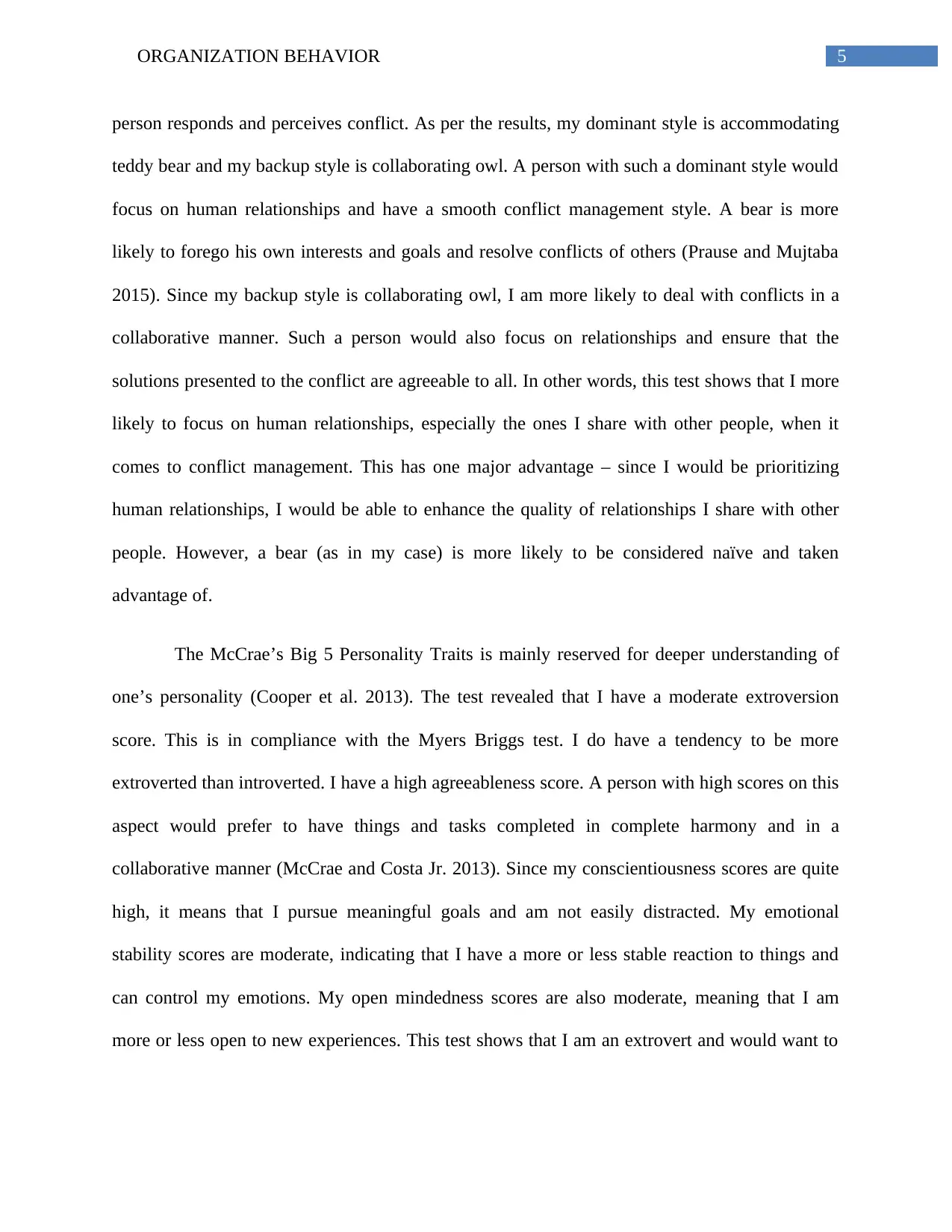
5ORGANIZATION BEHAVIOR
person responds and perceives conflict. As per the results, my dominant style is accommodating
teddy bear and my backup style is collaborating owl. A person with such a dominant style would
focus on human relationships and have a smooth conflict management style. A bear is more
likely to forego his own interests and goals and resolve conflicts of others (Prause and Mujtaba
2015). Since my backup style is collaborating owl, I am more likely to deal with conflicts in a
collaborative manner. Such a person would also focus on relationships and ensure that the
solutions presented to the conflict are agreeable to all. In other words, this test shows that I more
likely to focus on human relationships, especially the ones I share with other people, when it
comes to conflict management. This has one major advantage – since I would be prioritizing
human relationships, I would be able to enhance the quality of relationships I share with other
people. However, a bear (as in my case) is more likely to be considered naïve and taken
advantage of.
The McCrae’s Big 5 Personality Traits is mainly reserved for deeper understanding of
one’s personality (Cooper et al. 2013). The test revealed that I have a moderate extroversion
score. This is in compliance with the Myers Briggs test. I do have a tendency to be more
extroverted than introverted. I have a high agreeableness score. A person with high scores on this
aspect would prefer to have things and tasks completed in complete harmony and in a
collaborative manner (McCrae and Costa Jr. 2013). Since my conscientiousness scores are quite
high, it means that I pursue meaningful goals and am not easily distracted. My emotional
stability scores are moderate, indicating that I have a more or less stable reaction to things and
can control my emotions. My open mindedness scores are also moderate, meaning that I am
more or less open to new experiences. This test shows that I am an extrovert and would want to
person responds and perceives conflict. As per the results, my dominant style is accommodating
teddy bear and my backup style is collaborating owl. A person with such a dominant style would
focus on human relationships and have a smooth conflict management style. A bear is more
likely to forego his own interests and goals and resolve conflicts of others (Prause and Mujtaba
2015). Since my backup style is collaborating owl, I am more likely to deal with conflicts in a
collaborative manner. Such a person would also focus on relationships and ensure that the
solutions presented to the conflict are agreeable to all. In other words, this test shows that I more
likely to focus on human relationships, especially the ones I share with other people, when it
comes to conflict management. This has one major advantage – since I would be prioritizing
human relationships, I would be able to enhance the quality of relationships I share with other
people. However, a bear (as in my case) is more likely to be considered naïve and taken
advantage of.
The McCrae’s Big 5 Personality Traits is mainly reserved for deeper understanding of
one’s personality (Cooper et al. 2013). The test revealed that I have a moderate extroversion
score. This is in compliance with the Myers Briggs test. I do have a tendency to be more
extroverted than introverted. I have a high agreeableness score. A person with high scores on this
aspect would prefer to have things and tasks completed in complete harmony and in a
collaborative manner (McCrae and Costa Jr. 2013). Since my conscientiousness scores are quite
high, it means that I pursue meaningful goals and am not easily distracted. My emotional
stability scores are moderate, indicating that I have a more or less stable reaction to things and
can control my emotions. My open mindedness scores are also moderate, meaning that I am
more or less open to new experiences. This test shows that I am an extrovert and would want to
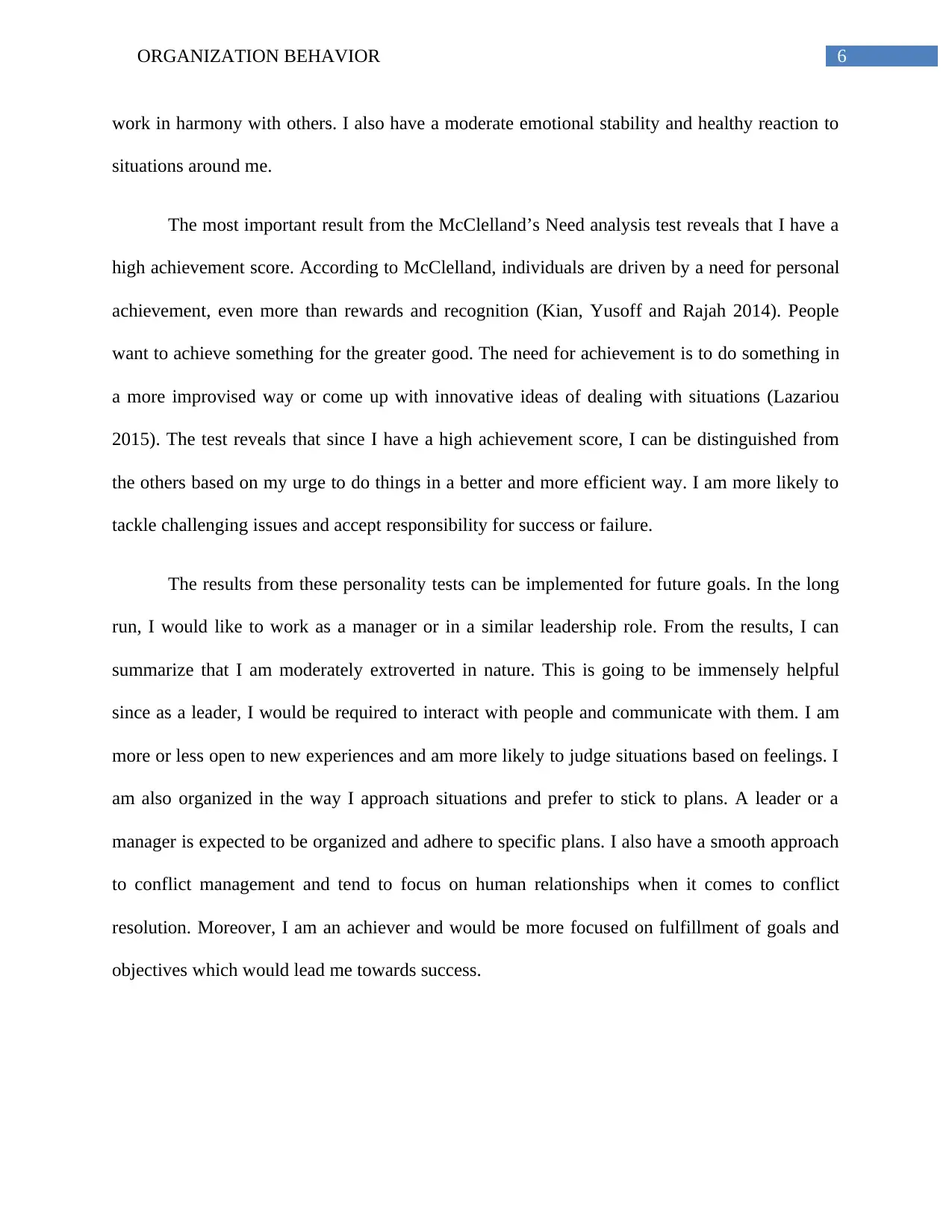
6ORGANIZATION BEHAVIOR
work in harmony with others. I also have a moderate emotional stability and healthy reaction to
situations around me.
The most important result from the McClelland’s Need analysis test reveals that I have a
high achievement score. According to McClelland, individuals are driven by a need for personal
achievement, even more than rewards and recognition (Kian, Yusoff and Rajah 2014). People
want to achieve something for the greater good. The need for achievement is to do something in
a more improvised way or come up with innovative ideas of dealing with situations (Lazariou
2015). The test reveals that since I have a high achievement score, I can be distinguished from
the others based on my urge to do things in a better and more efficient way. I am more likely to
tackle challenging issues and accept responsibility for success or failure.
The results from these personality tests can be implemented for future goals. In the long
run, I would like to work as a manager or in a similar leadership role. From the results, I can
summarize that I am moderately extroverted in nature. This is going to be immensely helpful
since as a leader, I would be required to interact with people and communicate with them. I am
more or less open to new experiences and am more likely to judge situations based on feelings. I
am also organized in the way I approach situations and prefer to stick to plans. A leader or a
manager is expected to be organized and adhere to specific plans. I also have a smooth approach
to conflict management and tend to focus on human relationships when it comes to conflict
resolution. Moreover, I am an achiever and would be more focused on fulfillment of goals and
objectives which would lead me towards success.
work in harmony with others. I also have a moderate emotional stability and healthy reaction to
situations around me.
The most important result from the McClelland’s Need analysis test reveals that I have a
high achievement score. According to McClelland, individuals are driven by a need for personal
achievement, even more than rewards and recognition (Kian, Yusoff and Rajah 2014). People
want to achieve something for the greater good. The need for achievement is to do something in
a more improvised way or come up with innovative ideas of dealing with situations (Lazariou
2015). The test reveals that since I have a high achievement score, I can be distinguished from
the others based on my urge to do things in a better and more efficient way. I am more likely to
tackle challenging issues and accept responsibility for success or failure.
The results from these personality tests can be implemented for future goals. In the long
run, I would like to work as a manager or in a similar leadership role. From the results, I can
summarize that I am moderately extroverted in nature. This is going to be immensely helpful
since as a leader, I would be required to interact with people and communicate with them. I am
more or less open to new experiences and am more likely to judge situations based on feelings. I
am also organized in the way I approach situations and prefer to stick to plans. A leader or a
manager is expected to be organized and adhere to specific plans. I also have a smooth approach
to conflict management and tend to focus on human relationships when it comes to conflict
resolution. Moreover, I am an achiever and would be more focused on fulfillment of goals and
objectives which would lead me towards success.
Paraphrase This Document
Need a fresh take? Get an instant paraphrase of this document with our AI Paraphraser
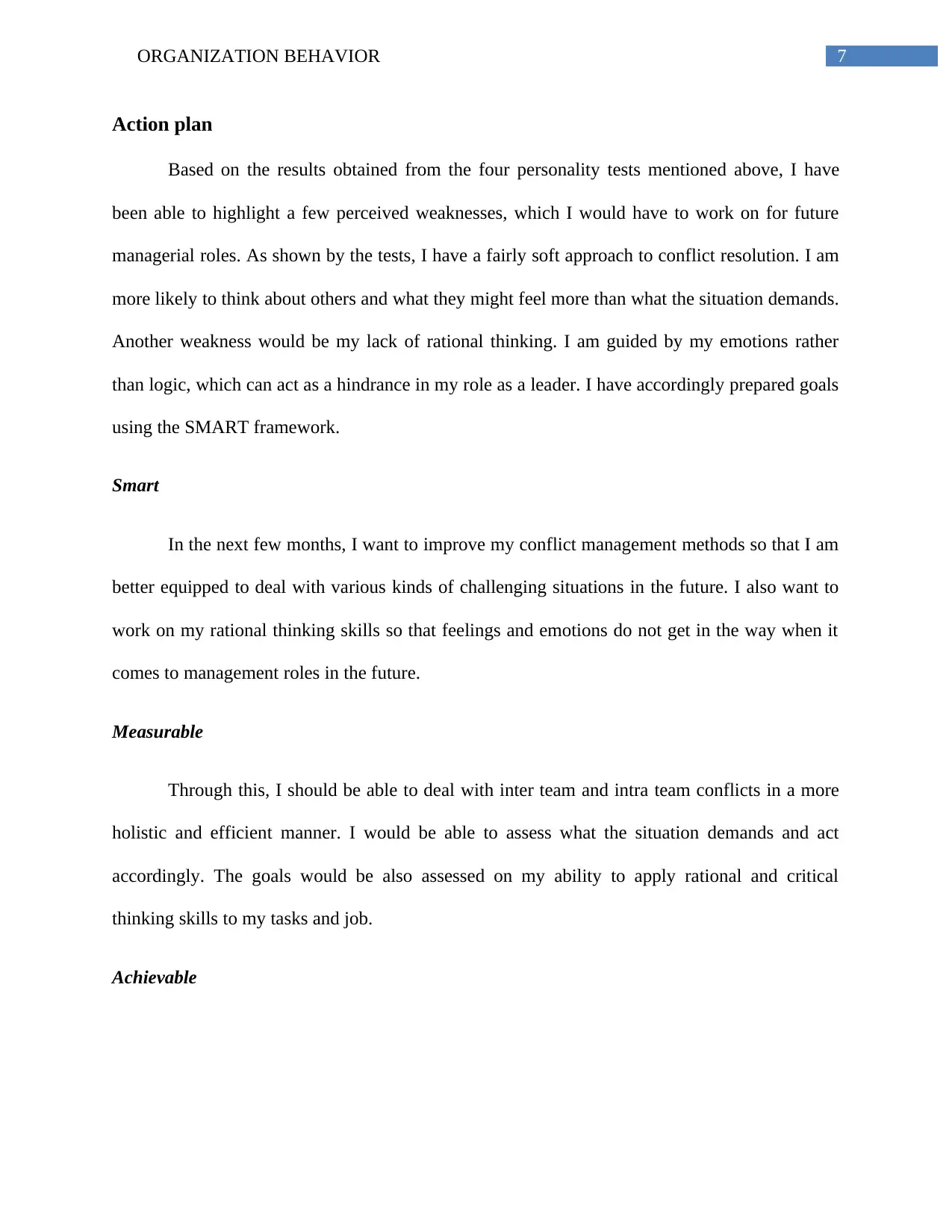
7ORGANIZATION BEHAVIOR
Action plan
Based on the results obtained from the four personality tests mentioned above, I have
been able to highlight a few perceived weaknesses, which I would have to work on for future
managerial roles. As shown by the tests, I have a fairly soft approach to conflict resolution. I am
more likely to think about others and what they might feel more than what the situation demands.
Another weakness would be my lack of rational thinking. I am guided by my emotions rather
than logic, which can act as a hindrance in my role as a leader. I have accordingly prepared goals
using the SMART framework.
Smart
In the next few months, I want to improve my conflict management methods so that I am
better equipped to deal with various kinds of challenging situations in the future. I also want to
work on my rational thinking skills so that feelings and emotions do not get in the way when it
comes to management roles in the future.
Measurable
Through this, I should be able to deal with inter team and intra team conflicts in a more
holistic and efficient manner. I would be able to assess what the situation demands and act
accordingly. The goals would be also assessed on my ability to apply rational and critical
thinking skills to my tasks and job.
Achievable
Action plan
Based on the results obtained from the four personality tests mentioned above, I have
been able to highlight a few perceived weaknesses, which I would have to work on for future
managerial roles. As shown by the tests, I have a fairly soft approach to conflict resolution. I am
more likely to think about others and what they might feel more than what the situation demands.
Another weakness would be my lack of rational thinking. I am guided by my emotions rather
than logic, which can act as a hindrance in my role as a leader. I have accordingly prepared goals
using the SMART framework.
Smart
In the next few months, I want to improve my conflict management methods so that I am
better equipped to deal with various kinds of challenging situations in the future. I also want to
work on my rational thinking skills so that feelings and emotions do not get in the way when it
comes to management roles in the future.
Measurable
Through this, I should be able to deal with inter team and intra team conflicts in a more
holistic and efficient manner. I would be able to assess what the situation demands and act
accordingly. The goals would be also assessed on my ability to apply rational and critical
thinking skills to my tasks and job.
Achievable
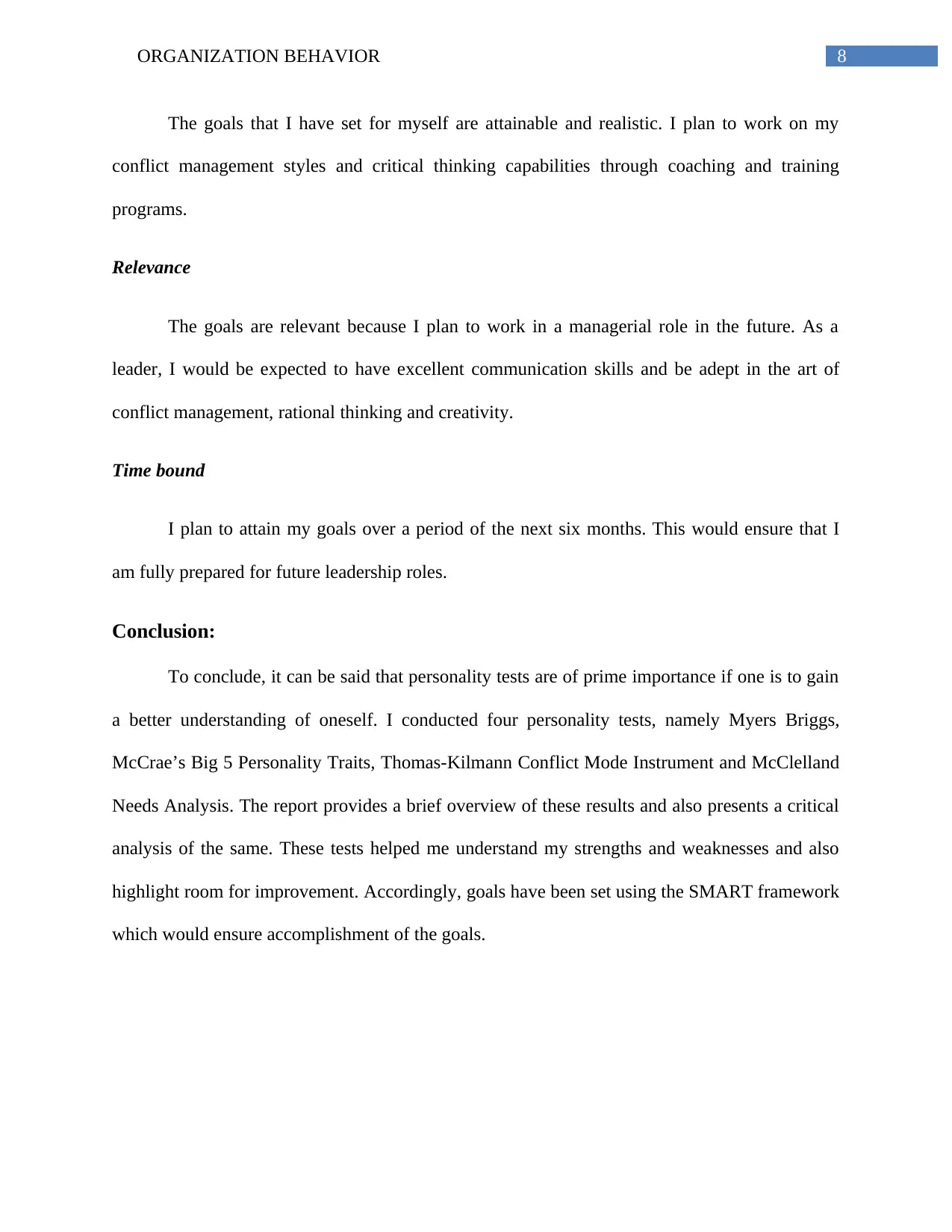
8ORGANIZATION BEHAVIOR
The goals that I have set for myself are attainable and realistic. I plan to work on my
conflict management styles and critical thinking capabilities through coaching and training
programs.
Relevance
The goals are relevant because I plan to work in a managerial role in the future. As a
leader, I would be expected to have excellent communication skills and be adept in the art of
conflict management, rational thinking and creativity.
Time bound
I plan to attain my goals over a period of the next six months. This would ensure that I
am fully prepared for future leadership roles.
Conclusion:
To conclude, it can be said that personality tests are of prime importance if one is to gain
a better understanding of oneself. I conducted four personality tests, namely Myers Briggs,
McCrae’s Big 5 Personality Traits, Thomas-Kilmann Conflict Mode Instrument and McClelland
Needs Analysis. The report provides a brief overview of these results and also presents a critical
analysis of the same. These tests helped me understand my strengths and weaknesses and also
highlight room for improvement. Accordingly, goals have been set using the SMART framework
which would ensure accomplishment of the goals.
The goals that I have set for myself are attainable and realistic. I plan to work on my
conflict management styles and critical thinking capabilities through coaching and training
programs.
Relevance
The goals are relevant because I plan to work in a managerial role in the future. As a
leader, I would be expected to have excellent communication skills and be adept in the art of
conflict management, rational thinking and creativity.
Time bound
I plan to attain my goals over a period of the next six months. This would ensure that I
am fully prepared for future leadership roles.
Conclusion:
To conclude, it can be said that personality tests are of prime importance if one is to gain
a better understanding of oneself. I conducted four personality tests, namely Myers Briggs,
McCrae’s Big 5 Personality Traits, Thomas-Kilmann Conflict Mode Instrument and McClelland
Needs Analysis. The report provides a brief overview of these results and also presents a critical
analysis of the same. These tests helped me understand my strengths and weaknesses and also
highlight room for improvement. Accordingly, goals have been set using the SMART framework
which would ensure accomplishment of the goals.

9ORGANIZATION BEHAVIOR
References
Cohen, Y., Ornoy, H. and Keren, B., 2013. MBTI personality types of project managers and their
success: A field survey. Project Management Journal, 44(3), pp.78-87.
Cooper, C.A., Knotts, H.G., McCord, D.M. and Johnson, A., 2013. Taking personality seriously:
the five-factor model and public management. The American Review of Public
Administration, 43(4), pp.397-415.
Fretwell, C.E., Lewis, C.C. and Hannay, M., 2013. Myers-Briggs Type Indicator, A/B
Personality Types, and Locus of Control: Where Do They Intersect?. American Journal of
Management, 13(3), pp.57-66.
Kian, T.S., Yusoff, W.F.W. and Rajah, S., 2014. Job satisfaction and motivation: What are the
difference among these two. European Journal of Business and Social Sciences, 3(2), pp.94-102.
Kline, P., 2015. Personality (Psychology Revivals): Measurement and Theory. Routledge.
Lazaroiu, G., 2015. Work motivation and organizational behavior. Contemporary Readings in
Law and Social Justice, 7(2), p.66.
McCrae, R.R. and Costa Jr, P.T., 2013. Introduction to the empirical and theoretical status of the
five-factor model of personality traits.
McShane, S. and Von Glinow, M., 2013. M Organizational Behavior. New York, New York:
McGraw-Hill/Irwin.
Prause, D. and Mujtaba, B.G., 2015. Conflict management practices for diverse
workplaces. Journal of Business Studies Quarterly, 6(3), p.13.
References
Cohen, Y., Ornoy, H. and Keren, B., 2013. MBTI personality types of project managers and their
success: A field survey. Project Management Journal, 44(3), pp.78-87.
Cooper, C.A., Knotts, H.G., McCord, D.M. and Johnson, A., 2013. Taking personality seriously:
the five-factor model and public management. The American Review of Public
Administration, 43(4), pp.397-415.
Fretwell, C.E., Lewis, C.C. and Hannay, M., 2013. Myers-Briggs Type Indicator, A/B
Personality Types, and Locus of Control: Where Do They Intersect?. American Journal of
Management, 13(3), pp.57-66.
Kian, T.S., Yusoff, W.F.W. and Rajah, S., 2014. Job satisfaction and motivation: What are the
difference among these two. European Journal of Business and Social Sciences, 3(2), pp.94-102.
Kline, P., 2015. Personality (Psychology Revivals): Measurement and Theory. Routledge.
Lazaroiu, G., 2015. Work motivation and organizational behavior. Contemporary Readings in
Law and Social Justice, 7(2), p.66.
McCrae, R.R. and Costa Jr, P.T., 2013. Introduction to the empirical and theoretical status of the
five-factor model of personality traits.
McShane, S. and Von Glinow, M., 2013. M Organizational Behavior. New York, New York:
McGraw-Hill/Irwin.
Prause, D. and Mujtaba, B.G., 2015. Conflict management practices for diverse
workplaces. Journal of Business Studies Quarterly, 6(3), p.13.
Secure Best Marks with AI Grader
Need help grading? Try our AI Grader for instant feedback on your assignments.
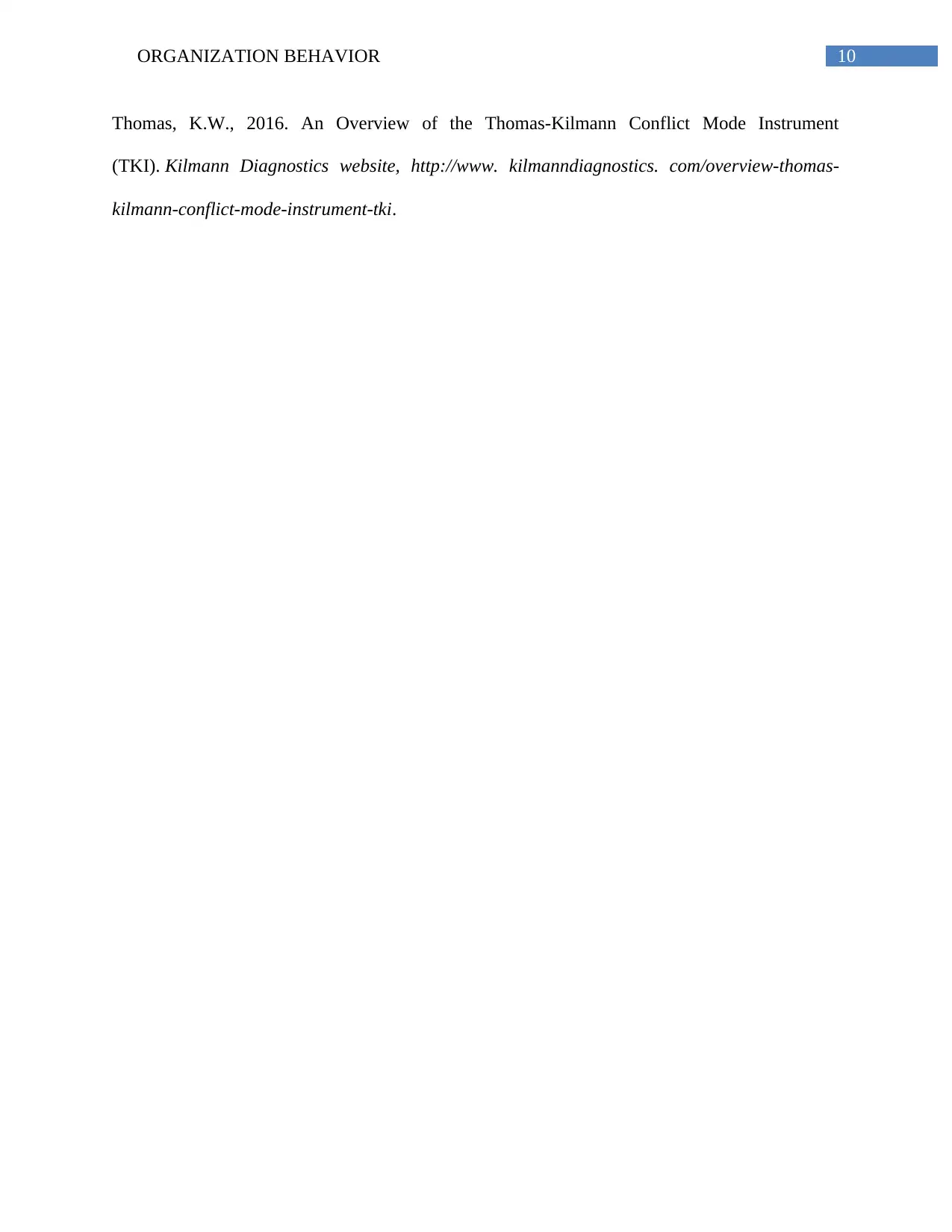
10ORGANIZATION BEHAVIOR
Thomas, K.W., 2016. An Overview of the Thomas-Kilmann Conflict Mode Instrument
(TKI). Kilmann Diagnostics website, http://www. kilmanndiagnostics. com/overview-thomas-
kilmann-conflict-mode-instrument-tki.
Thomas, K.W., 2016. An Overview of the Thomas-Kilmann Conflict Mode Instrument
(TKI). Kilmann Diagnostics website, http://www. kilmanndiagnostics. com/overview-thomas-
kilmann-conflict-mode-instrument-tki.
1 out of 11
Related Documents
Your All-in-One AI-Powered Toolkit for Academic Success.
+13062052269
info@desklib.com
Available 24*7 on WhatsApp / Email
![[object Object]](/_next/static/media/star-bottom.7253800d.svg)
Unlock your academic potential
© 2024 | Zucol Services PVT LTD | All rights reserved.





